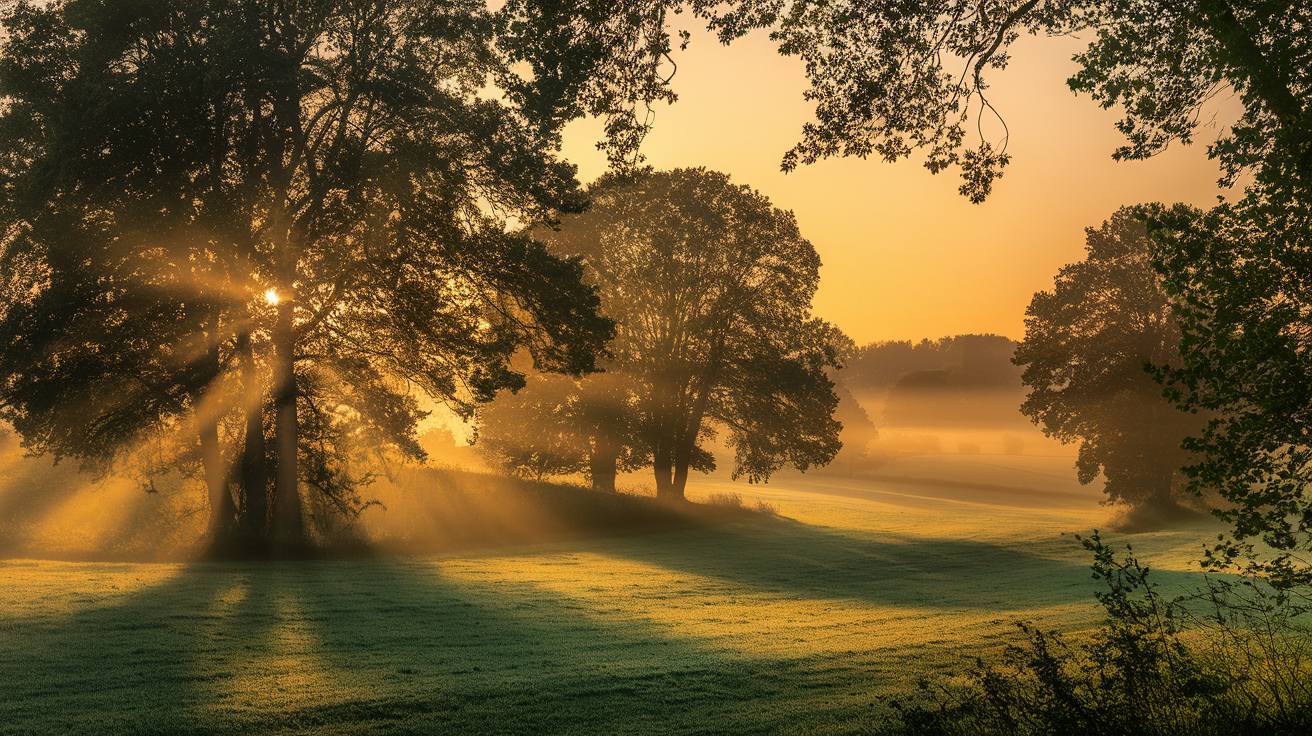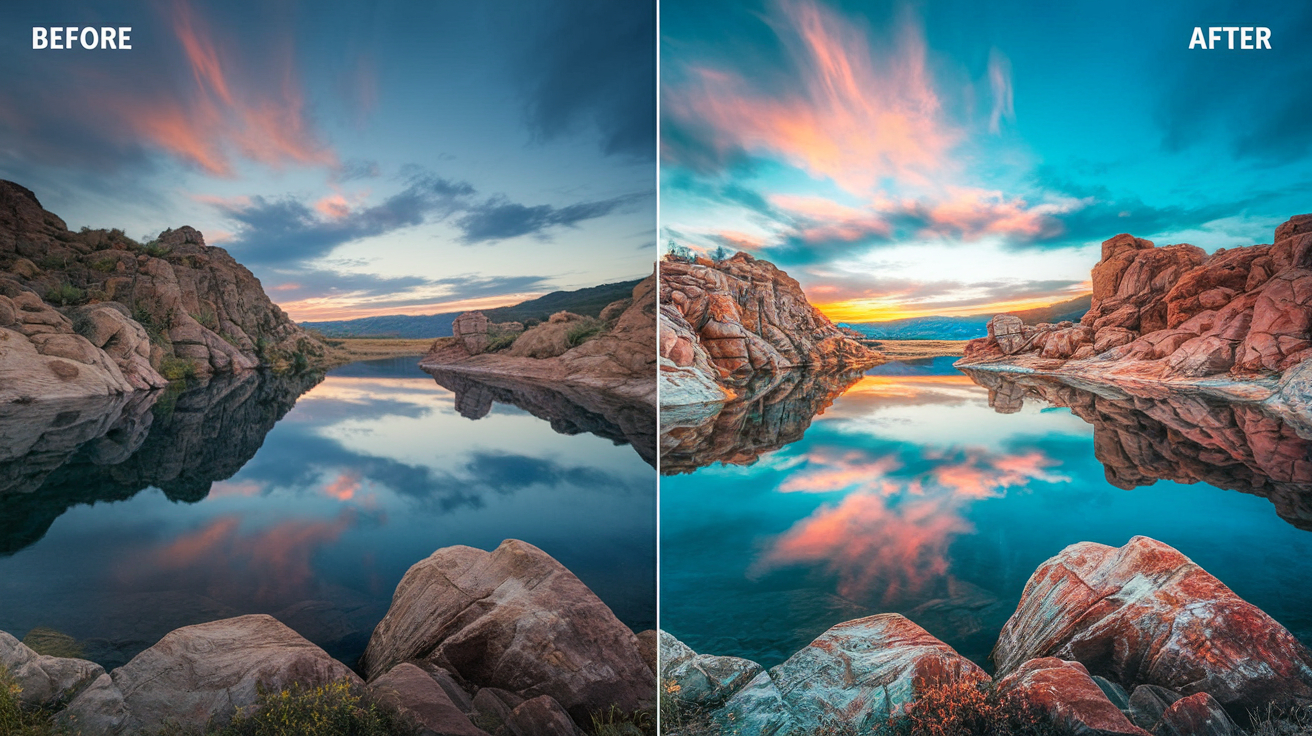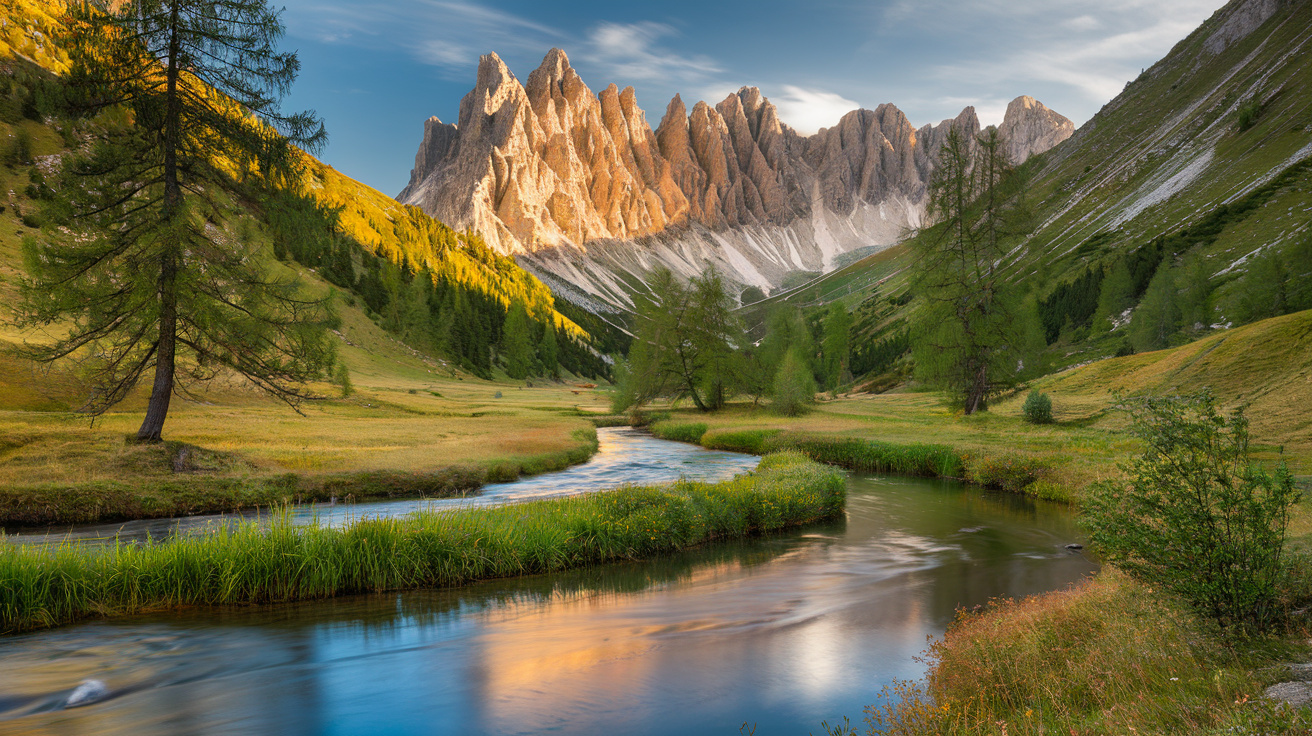Landscape photography tips are essential for anyone looking to capture the beauty of nature through their lens. Whether you’re a beginner or a seasoned photographer, there’s always more to learn about creating stunning landscape images. This guide will walk you through landscape photography tips, gear recommendations, and creative approaches to elevate your photography to the next level.
From mastering natural lighting to perfecting composition and exploring advanced post-processing techniques, the journey toward capturing breathtaking landscapes requires both technical expertise and creative vision. This comprehensive guide aims to equip you with all the knowledge you need to shoot amazing landscape photos consistently.
1. Mastering Natural Lighting: Essential Landscape Photography Tips

Lighting plays a crucial role in capturing stunning landscapes. The most magical moments often occur during the golden hour (just after sunrise or before sunset) and the blue hour (shortly after sunset or before sunrise). These times offer soft, diffused light that can enhance the natural beauty of your scenes.
- Golden Hour vs. Blue Hour: During the golden hour, warm hues dominate the sky, adding depth and warmth to your photos. The soft shadows and glowing light create an inviting atmosphere that makes landscapes look almost ethereal. Golden hour light is particularly flattering when shooting landscapes with water, as the warm glow is often reflected, adding extra vibrancy to your image. In contrast, the blue hour provides cooler tones, making it perfect for capturing serene and tranquil landscapes. This is an excellent time to shoot seascapes or images that convey a calm, peaceful mood.
- Weather Considerations: Don’t be afraid to shoot in unconventional weather conditions. Fog, rain, and storms can create dramatic effects, offering a sense of mystery or intensity in your images. Overcast skies provide even lighting, reducing harsh shadows and allowing more balanced exposures across your scene. Waiting for a break in the clouds can create stunning sunbeams or “god rays,” adding a touch of drama. By learning how to embrace different weather conditions, you can add depth and emotion to your landscape photography.
The key to mastering natural light in landscape photography is adaptability. Understanding how light interacts with your environment and knowing when and where to shoot can make a significant difference in the quality of your photos.
2. Composition Techniques for Stunning Landscapes
Good composition is key to making your landscape photos stand out. By organizing elements in your frame, you can lead the viewer’s eye through your photo and create a sense of balance and depth.
- Rule of Thirds and Framing: One of the simplest but most effective techniques is the rule of thirds. Divide your frame into nine equal parts using two horizontal and two vertical lines, then place your subject along these lines or their intersections. This helps create balance and harmony in your image. Framing also plays a crucial role in composition. You can use natural elements such as tree branches, rocks, or doorways to create a natural frame within your shot, directing the viewer’s focus toward the main subject.
- Leading Lines and Depth: Leading lines are an essential tool in landscape photography. Use natural elements such as rivers, paths, or roads as leading lines that guide the viewer’s eye from the foreground to the background. This technique creates a sense of movement and directs the viewer’s attention through the scene. Combining this with layers of foreground, middle ground, and background enhances the sense of depth and scale in your photos, making the image feel more immersive.
Incorporating strong compositional techniques can transform an ordinary landscape into something extraordinary, guiding the viewer to fully experience the beauty of the scene.
3. Using Filters to Enhance Your Landscape Photography

Filters are essential tools in landscape photography, helping to manage challenging lighting conditions and enhance the natural beauty of your scene. They can help control reflections, increase contrast, and allow for longer exposures that add creative effects.
- Polarizing Filters: Polarizing filters are excellent for reducing glare from water, wet surfaces, or reflective materials, and for enhancing the contrast in skies and clouds. When photographing a lake or river, a polarizing filter can cut through the surface reflection, revealing the natural beauty beneath the water. They are also highly effective in making colors appear richer and more saturated, especially in scenes with lush greenery or vibrant skies.
- Neutral Density (ND) Filters: ND filters reduce the amount of light entering the camera, allowing for longer shutter speeds even in bright conditions. This makes them ideal for creating silky water effects in rivers, waterfalls, or the ocean. A slow shutter speed of 1/4 second or longer smooths out flowing water and creates a dreamy, otherworldly effect. ND filters can also be used to blur the motion of clouds in the sky, adding a sense of movement and drama to your shots.
- Graduated ND Filters: These filters are designed to balance exposure between the bright sky and darker land in your frame, ensuring that both are well-exposed. This is particularly useful in scenes with a strong contrast between the sky and the ground, such as a sunset over the mountains. Without this filter, either the sky would be too bright or the landscape too dark. By using graduated ND filters, you can capture more balanced and visually appealing images.
Filters are indispensable tools for any landscape photographer, allowing for greater control over lighting and creative expression in your images.
4. Gear Essentials for Professional Landscape Photography: Tips and Tricks
While talent and creativity are key, having the right gear can help you achieve the best results in landscape photography. Investing in high-quality equipment ensures you’re prepared for a variety of conditions and allows you to get the most out of each shot.
- Best Lenses for Landscape Photography: A wide-angle lens is perfect for capturing expansive scenes, such as sweeping vistas, mountain ranges, or large bodies of water. This type of lens allows you to fit more into the frame, enhancing the sense of scale in your photos. On the other hand, a telephoto lens is useful for isolating distant subjects, such as a lone tree or mountain peak, and compressing the elements within your frame. Both lenses serve different purposes but are invaluable tools for any landscape photographer.
- Tripods and Stability: Long exposures and precise framing are essential in landscape photography, which is why a sturdy tripod is a must. It helps you avoid camera shake and ensures sharp images, even in low-light conditions or during long exposure shots. When photographing at sunrise, sunset, or in low light, hand-held shots can result in blurry images, but a tripod allows you to maintain stability and capture crisp details.
- Other Essential Gear: A remote shutter release allows you to take photos without touching the camera, reducing the risk of camera shake during long exposures. Lens hoods are also useful for preventing unwanted lens flare, which can reduce the contrast and clarity of your images.
By having the right tools in your kit, you can ensure that your technical setup supports your creative vision in landscape photography.
5. Capturing Motion in Landscapes (Waterfalls, Clouds, etc.)

Capturing motion in landscapes can add a dynamic element to your photography, turning an ordinary scene into something extraordinary. Whether it’s the flowing water of a waterfall or the movement of clouds across the sky, motion can bring life and energy to your images.
- Long Exposure Techniques: To capture the smooth, flowing motion of water in waterfalls or the streaks of clouds across the sky, use a slow shutter speed combined with an ND filter. A shutter speed of 1/4 second or slower will blur the motion, creating a sense of movement and fluidity in the image. When photographing fast-moving water, like a river or waterfall, a longer exposure will smooth out the flow, creating a silky effect that contrasts beautifully with the surrounding still elements.
- Camera Settings for Motion: For most landscape motion shots, use a small aperture (f/11 or higher) to ensure a deep depth of field, and a low ISO to avoid noise in your images. It’s essential to balance the exposure by adjusting the shutter speed and aperture to create the desired motion effect without overexposing the scene.
Incorporating motion into your landscapes can create images that evoke a sense of wonder and serenity, making the viewer feel as though they are standing right there in the scene.
6. Post-Processing Landscape Photography Tips to Make Your Photos Pop
Post-processing is an essential step in refining your landscape photography. With editing software like Lightroom or Photoshop, you can enhance the colors, contrast, and overall mood of your images.
- Basic Adjustments: Start by correcting exposure, contrast, and white balance. These simple adjustments can significantly improve the clarity and balance of your images. If your photo appears too dark or bright, adjusting the exposure can bring out more detail. Balancing the contrast helps to differentiate the highlights and shadows, giving your image more depth.
- Advanced Edits: Use selective adjustments to enhance specific areas of your image. For instance, increasing the saturation in the sky or adding clarity to the mountains can make certain elements pop without over-editing the entire photo. Additionally, removing distractions such as power lines or people from the background using cloning or healing tools can help keep the focus on the main subject.
Effective post-processing can elevate your landscape photos by enhancing details, colors, and contrast while preserving their natural beauty. The key is to find a balance between improving the image and maintaining the authenticity of the scene, ensuring that the final result stays true to what you captured. For more advanced editing techniques, check out Adobe’s Landscape Photography Editing Guide to take your post-processing skills to the next level.
7. Choosing the Perfect Location for Landscape Photography

- Scouting Locations: Use apps like Google Earth or Photographer’s Ephemeris to find new locations and plan your shots based on the position of the sun and other environmental factors. These tools allow you to preview potential shooting locations, study the terrain, and anticipate the light conditions throughout the day. This kind of preparation can be crucial for being in the right place at the right time to capture the perfect shot.
- Timing and Patience: Arriving at your location early gives you time to explore different angles and compositions before the ideal lighting conditions present themselves. Often, the best landscape photos come from patience and persistence—waiting for the sun to break through the clouds or for the wind to calm down, creating the perfect reflection in a lake. Sometimes, you may need to revisit a location multiple times to get the right conditions, but the payoff is worth the effort when you capture a truly breathtaking image.
Scouting and timing are critical aspects of landscape photography that require both planning and patience. The more effort you put into finding and waiting for the right moment, the more rewarding your results will be.
8. Minimalist Landscape Photography Tips for Simple Yet Stunning Shots
Simplicity can often lead to the most powerful landscape photos. Minimalist photography emphasizes the beauty of less, focusing on one or two key elements to create striking, evocative images.
- Less is More: Focus on a single element of the landscape, such as a lone tree, mountain peak, or a stretch of shoreline. By isolating your subject and reducing distractions, you can create a clean and powerful image that draws the viewer’s attention to the most important part of the scene. Minimalist compositions can evoke a sense of calm, peace, or introspection, depending on how the elements are arranged.
- Negative Space: Don’t be afraid to leave large areas of your photo empty. Negative space—areas of the photo with little to no detail—can create a sense of vastness, especially when shooting landscapes like deserts or open fields. This space helps to emphasize the main subject and provides balance to the composition, making the overall image feel more harmonious.
Minimalism in landscape photography is about stripping away unnecessary elements and letting the natural beauty of the scene shine through. By embracing simplicity, you can create images that have a lasting impact on the viewer. For more minimalist landscape photography tips, visit National Geographic’s Landscape Photography Guide to learn how to capture striking images with minimal elements.
Conclusion
Shooting amazing landscape photography requires a balance of technical skill, creativity, and patience. By mastering lighting, composition, and post-processing techniques, you can capture stunning images that showcase the beauty of the natural world. For more tips on capturing breathtaking nature photography, check out our 10 Essential Nature Photography Tips. Whether you’re chasing golden hour light, experimenting with long exposures to capture motion, or exploring minimalist compositions, the key is to keep pushing your creative boundaries.
Landscape photography is an ongoing journey, and each shoot provides a new opportunity to learn and grow as a photographer. The more you practice, the better you’ll become at recognizing the subtle nuances that make a landscape extraordinary. So grab your gear, head out into nature, and start capturing the world in all its breathtaking glory.
